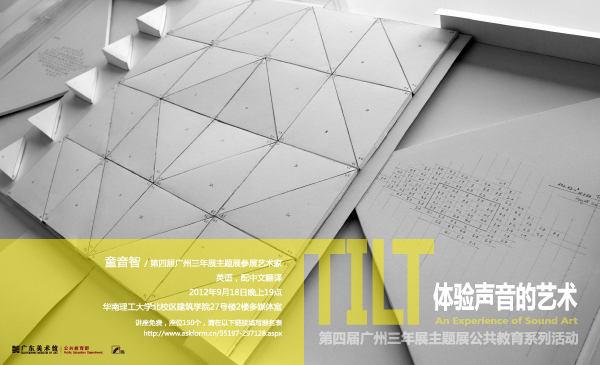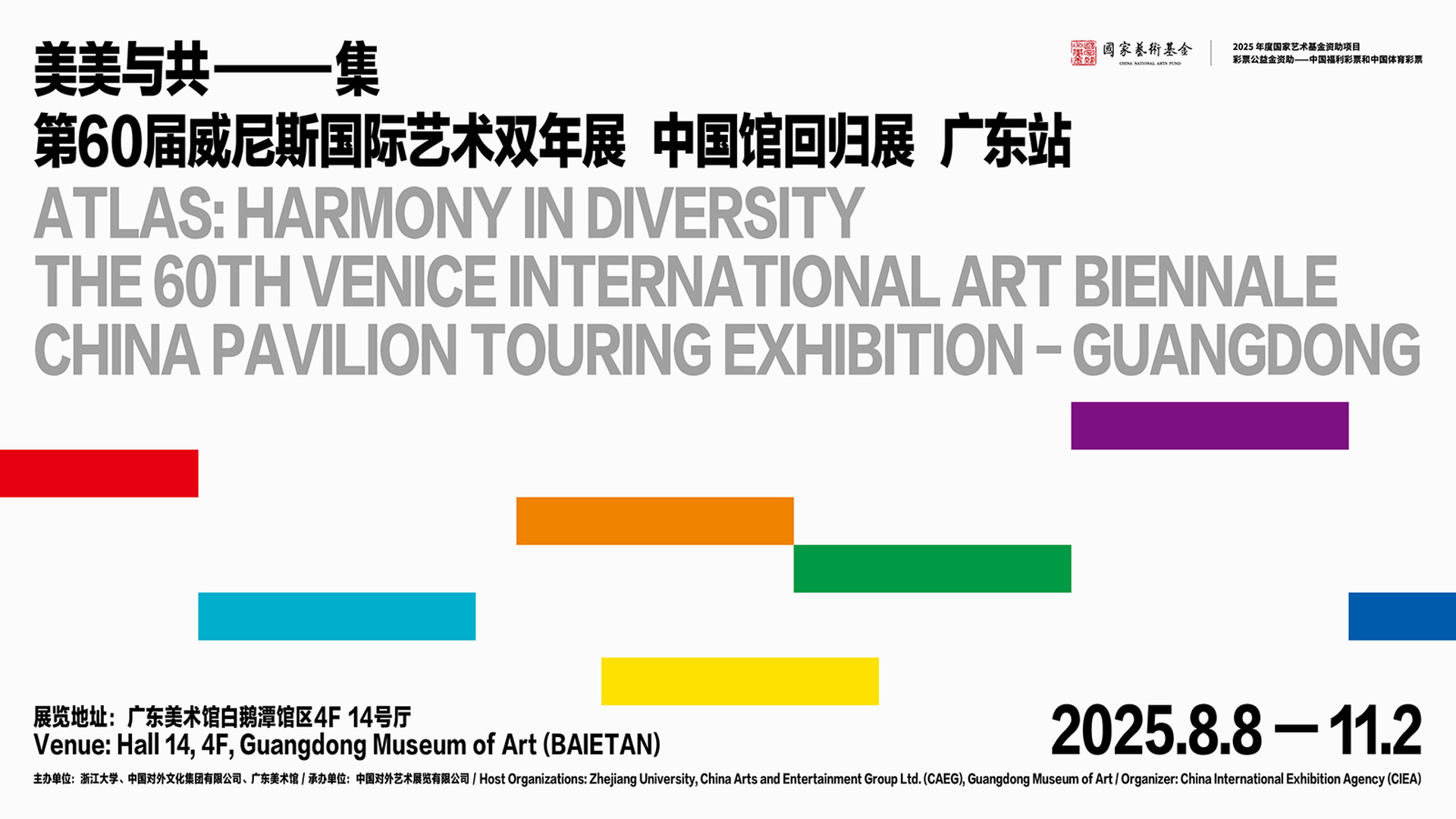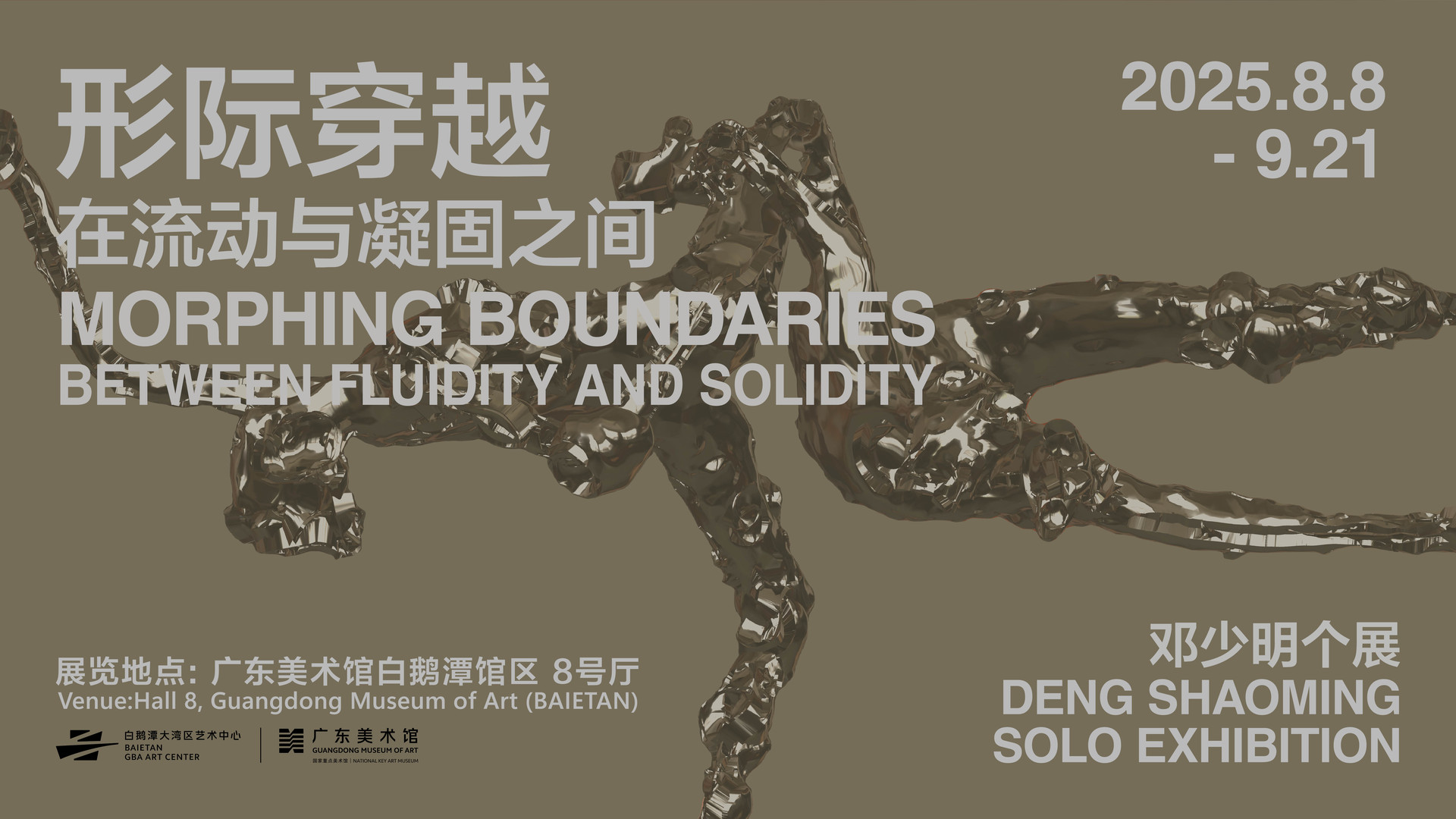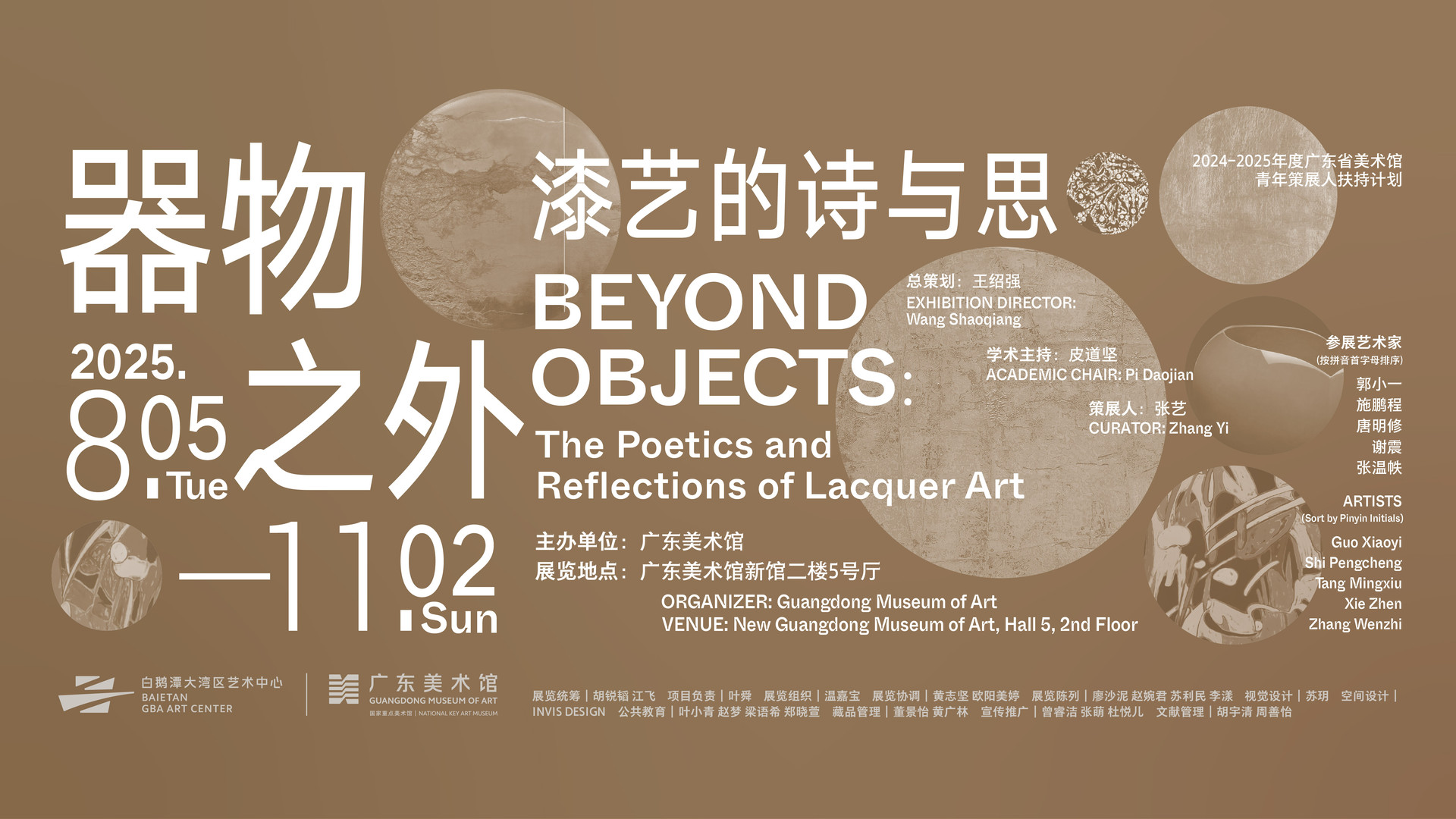【讲座】TILT:体验声音的艺术

TILT丨体验声音的艺术
主讲人:童音智(第四届广州三年展主题展参展艺术家)
时 间:9月18日晚上19点
地 点:华南理工大学北校区(天河区五山路381号)建筑学院27号楼2楼多媒体室
主 办:广东美术馆公共教育部、华南理工大学筑学社
报名方式
* 本次讲座免费参加,现场座位150个,请填写报名表:http://www.askform.cn/55197-297128.aspx
* 英文配中文翻译。
* 本次讲座免费参加,现场座位150个,请填写报名表:http://www.askform.cn/55197-297128.aspx
* 英文配中文翻译。
活动内容
第四届广州三年展主题展的话题是“见所未见”,策展人说:“‘未见’是一次旅行的出发,在时间维度或是空间维度上,展开以视觉为渠道的想象。”人们习惯于“看”艺术,但其实艺术不仅仅局限于“眼睛”所见的范围。声音、触觉、嗅觉等都可以成为艺术的载体。因此,两位策展人选择了多位声音艺术家,来呈现“看不见”的别样世界。这些独特的“声音艺术”将带领观众从视觉的领域出发,去探寻声音的世界。也许你会问:声音艺术跟我们所熟悉的音乐有什么不同?声音艺术家又是怎样思考和创作的呢?为了解答这些问题,我们邀请来自印度尼西亚的声音艺术家童音智(Angie ATMADJAJA)与大家分享她的艺术故事,以及声音艺术的巧妙所在。
第四届广州三年展主题展的话题是“见所未见”,策展人说:“‘未见’是一次旅行的出发,在时间维度或是空间维度上,展开以视觉为渠道的想象。”人们习惯于“看”艺术,但其实艺术不仅仅局限于“眼睛”所见的范围。声音、触觉、嗅觉等都可以成为艺术的载体。因此,两位策展人选择了多位声音艺术家,来呈现“看不见”的别样世界。这些独特的“声音艺术”将带领观众从视觉的领域出发,去探寻声音的世界。也许你会问:声音艺术跟我们所熟悉的音乐有什么不同?声音艺术家又是怎样思考和创作的呢?为了解答这些问题,我们邀请来自印度尼西亚的声音艺术家童音智(Angie ATMADJAJA)与大家分享她的艺术故事,以及声音艺术的巧妙所在。
讲座英文稿:ggjy.gdmoa.org/zyxz/2/23734.shtml
主讲人介绍
童音智(Angie ATMADJAJA)是一位声音艺术家,在曼彻斯特工作和生活。她最近刚在约克大学音乐研究中心完成她的实践型博士学位课程。其作品主要围绕于搭建空灵、抽象和极简的声音/视觉装置,并通过这些装置来探究心理声学和声学现象。她创作艺术品时使用音调纯正的声音素材,例如正弦波和经过人工过滤的生活噪音,这种素材发出的清晰的声音能让观众置身于纯体验式的境界,如同声音就是能感知的有形实体。
她的作品《倾斜》(TILT)是根据不同场地而量身打造声音的一系列装置,着重于反映声音、空间和感知能力三者之间的关系。《倾斜》致力于打造完全沉浸式的体验,让观众感受声音的交融汇总和空间的自由穿梭,纷繁的体验背后作品意图简单如一。与作品的面对面交流不可或缺,这能让每位细腻的听众都有一次独特的经历,即用声音和视觉来认知空间和他们自己的关系。本次讲座将会探讨童音智艺术家目前正在进行的声音研究,让听众更好地了解和感受《倾斜》的魅力。
英文讲稿
Good evening and thank you for being here.
I am Angie and my Chinese name is 童音智. And this is Brenda, my translator for the night. She and I will alternate to provide you with both English and Mandarin translation for the next hour.
Tonight I will be discussing about the work TILT that will be presented as part of the 4th Guangzhou Triennial, but first I would like to begin by giving you a short background explaining how I’ve come to make sound installations, to share with you a short story about my own journey with sound.
When I was young, my father gave me the name Tong Yin Zhi(童音智). It means a child wise or knowledgeable in sound. But what is wisdom and knowledge? According to Wikipedia, wisdom is a deep understanding and realization while knowledge is information and skills acquired through experience.
So within this sharing it is my own experience that I would like to offer you tonight, my encounter, experience and relationship with sound.
When I was very young, I was placed at the piano as soon as I could walk and talk. So my first encounter and experience of musical sound is the sound of the piano.
I learnt to control the notes on the piano, to hear the brightness and darkness of each tone. A light touch will bring lightness to the sound while a heavy touch will give the sound a full-bodied tone.
I most enjoyed listening to the varying effects of the pedals, like shifting colors with different depths of intensities.
Once my fingers have learned to control the piano, I was taught that just learning to control the instrument wasn’t enough. A pianist must think about the music that she or he plays. So my experience of sound grew to include the wishes and thinking of the composer. How certain composers wished to convey his feelings of a moment or to paint a landscape through organizing the musical sound.
And through a deeper understanding, I allowed the composer to speak through me. But this soon was not enough for me because I wanted to speak too.
In the final year of my bachelor degree at Trinity College of Music, I changed my major from piano to composition. I began to work instead with electronic equipment, orchestras and instrumental ensembles. My experience of sound by now shifted to the crafting of time, to learn how to sculpt sound through time and timbre and very quickly it too would include space.
In the final year of my bachelor degree, I wrote and organized the performance of my opera, ‘Converting maidenhood’.
Within a round theatre, 6 women sits and gradually dies one by one as the opera is nearing the end.
Surrounding the women was the audience.
Surrounding the audience were three male percussionists with large instruments such as gongs, vibraphones, timpani, thunder sheets and many others.
And finally at the other edge is a set of stereo loudspeakers.
The story unfolds around 6 women imprisoned in a small cell guarded by 3 male guards. I wanted to place the audience within the same prison cell as the women, to confine them sonically in a cocoon of concentric circles, a feeling of oppression not just sonically but also visually.
Audience entering this environment encountered the work depending on where they sat in the space and in particular where they were facing. If an audience sat as indicated by the yellow arrow symbol, he or she would hear the percussions through his left, front and right ears while facing the singers. At the same time, he will experience electronic sound from the speakers from the front and behind.
This was the first beginning of working with sound not only through time and timbre but also controlling the directivity of sound, what we term as sound specialization.
A few years later, I began working with contemporary dance companies. I took my knowledge of sound into spatial design for theatres. During this period, I was incredibly fortunate to work with so many inspiring contemporary dance choreographers around Europe. With every dance collaboration commission, I gain a renewed understanding of working with sound with movement. And with each project, I was able to use the platform to carry out sound experiments of my own.
One particular spatial sound experiments I carried out were in a commission titled ‘Procession’ with the German company Commerce.
[Play video of ‘procession’ (10’)]
[Play video of ‘procession’ (10’)]
In a performance of ‘Procession’, the video you’ve just seen, at Mousonturm in Frankfurt, Germany, I placed 6 loudspeakers in the ceiling of the huge dance theatre. By doing so, I created an artificial digital rain environment. In this work, two men were conjoined through their faces for 45 minutes. The work explored shapes and balance between the two supporting bodies without any loss of contact. Some of the shapes their bodies made reminded me of architecture or sculpture.
But while working with dance, I received a very important lesson.
At each commission, I usually spend a lot of time in dance rehearsals watching the dancers work away. In one particular rehearsal with Blue White Dance Company in London, I noticed that the dancers were dancing in time in complete silence. At the end of the rehearsal, I asked the dancers, how were they dancing together in perfect synchronicity? How were they able to be in sync with each other without any aid from music? And they said that they were constantly listening to each other not only through their ears and eyes.
While they were listening to the breaths as well as the sounds from the bodies, they were also feeling the vibration through their feet. Through this, they were constantly aware of the proximity of their bodies in relation to each other.
This made me question the act of listening through the bodies and in particular moving bodies. This fascination has stayed for many years since and has led me to make sound installations that investigate the way we experience sound, and in particular the way we listen to sound as we move through spaces.
This made me question the act of listening through the bodies and in particular moving bodies. This fascination has stayed for many years since and has led me to make sound installations that investigate the way we experience sound, and in particular the way we listen to sound as we move through spaces.
So, Let us now take a deeper look at the work TILT.
What is TILT?
TILT is a sound installation created in 2010 in Aomori Contemporary art Centre in Japan. The Centre was designed by Tadao Ando. I have always loved Ando’s vision in how he aims to bring harmony between nature and human intervention.
Visitors enter a white clean space without any visual information and encounter a low sounding tone. When they explored the space, their bodies tilt and their ears hear the changes in the volume of the sound. In the case of Aomori Centre, it’s a structure that is very much placed in the heart of a forest, hidden from view unless one ventures deeper into it. I was very much seduced by this idea, the idea of being unable to see but instead it reveals itself only when one looks deep within.
This video is a simulation of what you will be experiencing in the space. As you can see from the video, the sound is changing by becoming louder and softer as one explores the space, why is this happening?
In the space, one loudspeaker injects a sine wave, or a singular physical vibration. This singular vibration is then reflected back by the walls, floor and ceilings of the space. When the original sound and reflected sound coincides, you create a phenomenon called standing waves. Within this standing waves phenomena, peaks and troughs of amplitude of sound is created. What does this mean? At different positions in the space, you will hear the sound at different varying loudness. The varying differences are then collected and translated into the heights of the floor, and thus visitors feel their bodies tilting in the space.
TILT in its complexity is a meeting point between architecture, sound and perception. Let’s pause and take a closer look at each of these three aspects.
Let’s talk about space. All surfaces have a reflective quality. I’m sure most of you have experience walking in a cave or through mountains and when you shout loudly into the space, you hear an echo returning caused by the reflection of the surfaces. Different materials are better at reflecting than others. At the same time, spaces with different dimensions change the way the sound is reflected back. We know that when sound waves are reflected and coincide with the original wave, we get standing waves. So when we walk through the space, we hear varying loudness in the sound. This topography though changes according to which frequency you use and the dimensions of that space. What is frequency?
Let’s us now talk about sound and our perception of sound?
Let’s us now talk about sound and our perception of sound?
Most of the people encounter sound as music in their everyday lives. Especially, with the advancement of technology, the younger generations are now constantly attached to their iPhones, iPods and any other listening device. They are never aware of the sonic environment but are instead constantly accompanied by music. But is music sound? Is sound noise?
John Cage, one of the greatest thinkers of sound once said,
Wherever we are, what we hear is mostly noise. When we ignore it, it disturbs us. When we listen to it, we find it fascinating.
Sound is vibrations that travel through the air or another medium that can be heard when they reach the ear. And by this definition, everything we can hear is sound. So all music and noise are just categories of sounds. While noise is a term used to label unwanted sound, music is a term used to label organized sound.
Sound is vibrations that travel through the air or another medium that can be heard when they reach the ear. And by this definition, everything we can hear is sound. So all music and noise are just categories of sounds. While noise is a term used to label unwanted sound, music is a term used to label organized sound.
In an odd turn of events, when I look back at my past, I feel like I have returned to my origins. After a very long journey of working with sound through its many facets, I have returned once more to working with sound as pure material. By disregarding its temporal and timbale entities, I wanted to work with sound through its phenomenology, the physical and direct experience of sound.
Before we discuss the phenomenology of sound, I would like to divert a little and discuss how we as a society have desensitized our hearing senses.
When we were once hunters, in order to survive, we relied not only on our eyes but also our ears too. Let’s take a moment here to listen to our surroundings. Close your eyes for the next few minutes and closely listen to every sound surrounding you. What do you hear?
[Listening exercise (1 minute)]
I can hear…..and I am aware of…..but my eyes can’t see them.
We perceive more through our ears than our eyes. When we hunt, our eyes can only see a certain distance but our ears can perceive further and allow us to follow our prey. This ability is perhaps even more crucial at night when we have to protect ourselves from incoming attacks from animals in higher food chain.
We are now at an era where we are beginning to be aware of pollution and the way we have been mistreating our mother earth.
Countries around the world are beginning to encourage the act of recycling.
I am though still waiting for the day when people are more aware about the noise pollution they are causing in the environment. For example, as I climbed Baiyun Mountain last Saturday, I was amused at how many people hiking around the mountain were carrying their own sound speakers, blasting and masking the beautiful sound of nature with music. Instead of listening to the music through a pair of headphones, they do not realize how they are polluting the environment with unwanted noise. Now let’s take a look at the extreme use of noise pollution.
In 2009, at a G20 summit in Pittsburgh, hundreds of protestors experienced the effects of piercing sound. It was the first time that a sonic weapon also called “sound cannon”, was researched by the US military and used on their own citizens. This is one of the many uses of sound through its physical properties. Through history of war, sound recordings had been used as a weapon to confuse the enemies in battles or as means of torture.
Extremely high-power sound waves can disrupt or destroy eardrums of a target and cause severe pain or disorientation. Through this way, a person can be incapacitated or experience nausea and discomfort.
Just this year in our London Olympics, similar technology was employed. According to the spokesman of the security, this high-powered sound canon, rather than deliver ear-piercing beams of sound, were used to deliver issued warnings. And furthermore, this technology have been modified to be portable as backpacks that can blast warnings at 137decibels as well as land-based loud hailers with a range of 0.6 miles.
So how do these technologies work? They are using sound through its physical properties. Sounds are simple vibrations with correlating frequencies and wavelengths. What are they?
We can look at the composition of all physical objects or matters through their building blocks, atoms. We can also look at the building blocks of sound. All sounds that you hear can be analyzed as frequencies. We as human with perfect hearing are able to hear between 20Hz and 20 KHz.
Our speaking voice is between the 85Hz to 255Hz.
Our mains electrical hum is at 50Hz.
Birds all over the world are both at the lower and higher range of the frequency spectrum.
While bats, being blind, use sound as echolocation through the ultrasound range (beyond 20 KHz), well beyond our hearing range.
Some of you may already know about echolocation? It is the act of projecting sound and hearing the reflection of that sound to determine your position. Submarines use this phenomenon as a navigation tool.
So in a summary.
TILT is the marriage between space, sound and hearing bodies.
TILT is also a marriage between architecture, science and arts.
And finally, TILT is also topography or acoustic architecture model of the space and yet because the model is installed as flooring, it is also a platform for interactivity and perception.
There are sound artists who investigate sound through sonic properties that refer to memories and direct relations to a specific environment and particular sound source. I do not share these concerns. I investigate sine waves and filtered noise through their physical properties, how they respond to a particular space and to the bodies encountering them.
Visitors do not enter TILT to perceive beyond their peripheral selves, they are instead made aware of their own perception; how their height, body weight, shape of their ears and the way they walk influence their perception.
Through TILT, the experience of each observer becomes the object of the art.
Thank you very much for giving me your time and attention. I apologies if some of the topics I discussed tonight are difficult to follow, so do feel free to email me at the address if you would like to find out more.
Thank you.
_______________________________________
+版权文字,转载请注明。
_______________________________________
+版权文字,转载请注明。
开放时间——每周二至周日9:00至17:00(16:30停止入场,16:45开始清场)
逢周一闭馆(法定节假日和特殊情况除外)。
广东美术馆新馆(白鹅潭):广东省广州市荔湾区白鹅潭南路19号
前台电话: (020) 88902999
广东美术馆本馆(二沙岛):广东省广州市越秀区二沙岛烟雨路38号
前台电话: (020) 87351468




